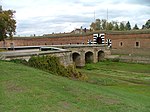Terezín
Cities and towns in the Czech RepublicForts in the Czech RepublicPages including recorded pronunciationsPages with Czech IPAPopulated places established in the 1780s ... and 3 more
Populated places in Litoměřice DistrictTerezínWorld War II sites in the Czech Republic

Terezín (Czech pronunciation: [ˈtɛrɛziːn] ; German: Theresienstadt) is a town in Litoměřice District in the Ústí nad Labem Region of the Czech Republic. It has about 2,800 inhabitants. It is a former military fortress composed of the citadel and adjacent walled garrison town. The town centre is well preserved and is protected by law as an urban monument reservation. Terezin is most infamously the location of the Nazis' notorious Theresienstadt Ghetto.
Excerpt from the Wikipedia article Terezín (License: CC BY-SA 3.0, Authors, Images).Terezín
Vodárenská, okres Litoměřice
Geographical coordinates (GPS) Address Nearby Places Show on map
Geographical coordinates (GPS)
| Latitude | Longitude |
|---|---|
| N 50.511111111111 ° | E 14.150555555556 ° |
Address
Terezín
Vodárenská
411 55 okres Litoměřice, Terezín
Czechia
Open on Google Maps








